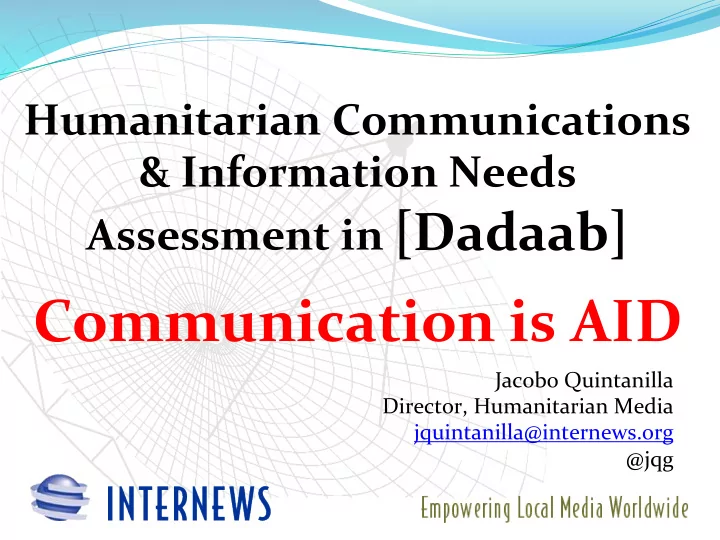

Humanitarian ¡Communications ¡ & ¡Information ¡Needs ¡ Assessment ¡in ¡ [Dadaab] ¡ ¡ ¡ Communication ¡is ¡AID ¡ Jacobo ¡Quintanilla ¡ Director, ¡Humanitarian ¡Media ¡ ¡ jquintanilla@internews.org ¡ ¡ @jqg ¡
What ¡is ¡Humanitarian ¡ Information? ¡ ¡ Information ¡ FOR ¡ affected ¡populations, ¡not ¡ ABOUT ¡ them ¡ ¡ ¡ ¡ ¡ ¡ ¡ ¡ ¡ Communication ¡ WITH ¡-‑ ¡Not ¡only ¡information ¡ TO ¡
Why is it important? Information ¡can ¡save ¡lives ¡ and ¡helps ¡to: ¡ ¡ 1. Manage ¡community ¡ EXPECTATIONS ¡ 2. Promote ¡ ACCOUNTABILITY ¡ 3. Improve ¡program ¡ QUALITY ¡ ¡ 4. Give ¡affected ¡populations ¡a ¡ VOICE ¡ ¡ The ¡Right ¡to ¡Know ¡ ¡
What’s ¡been ¡done ¡before? ¡ ¡ ¡ ¡ Pakistan ¡2005, ¡2009, ¡2010 ¡ Kosovo ¡ ¡ 1999 ¡ Afghanistan ¡1994+ ¡ Gaza ¡ 2009 ¡ Haiti ¡2010 ¡ Burma ¡2008 ¡ Iraq ¡ ¡ 2003 ¡ Sierra ¡Leone ¡ Sudan ¡2006 ¡ 2000 ¡ Indonesia ¡2004 ¡ Somalia ¡1997+ ¡ Sahel ¡ Kenya ¡2008 ¡ 2008 ¡ Great ¡Lakes ¡1994 ¡ Chad ¡ 2005 ¡ Sri ¡Lanka ¡2007 ¡
Milestones ¡(2001-‑2011) ¡ 2005 ¡ 2009 ¡ 2006 ¡ 2008 ¡ 2007 ¡ 2001 ¡ • ¡Bri%sh ¡Red ¡Cross ¡ • ¡Save ¡the ¡Children ¡ 2010-‑11 ¡ • ¡Thomson ¡Reuters ¡Founda%on ¡ • ¡Internews ¡ • ¡BBC ¡WST ¡ • ¡OCHA ¡
Dadaab, Kenya (August 2011)
Humanitarian ¡Communications ¡& ¡ Information ¡Needs ¡Assessment ¡of ¡ Refugee ¡Communities ¡in ¡Dadaab ¡ ¡ (August, ¡2011) ¡ ¡ ¡ ¡
Methodology ¡ ¡ Total ¡number ¡of ¡interviews ¡surveyed: ¡492 ¡ ¡ ¡ ¡ • Total ¡New ¡Arrivals ¡(9 ¡months ¡or ¡less): ¡237 ¡ • Total ¡Long ¡Term ¡Residents ¡(more ¡than ¡9 ¡months): ¡255 ¡ • Total ¡Males: ¡273 ¡ • Total ¡Females: ¡219 ¡ • Total ¡Youth ¡(25 ¡years ¡old ¡or ¡less): ¡189 ¡ • Total ¡Older ¡Generation ¡(older ¡than ¡25 ¡years): ¡303 ¡ ¡
1. ¡Top ¡Headlines ¡of ¡the ¡Assessment ¡(I) ¡ Large-‑scale ¡information ¡gap ¡putting ¡lives ¡ at ¡risk ¡& ¡hampering ¡aid ¡response ¡ ¡ Majority ¡of ¡refugees, ¡particularly ¡news ¡arrivals, ¡ do ¡ 1. not ¡have ¡the ¡information ¡ they ¡need ¡ 2. (+) ¡Radio, ¡friends ¡and ¡family ¡& ¡mobile ¡phones ¡ ¡ 3. (-‑) ¡Police ¡& ¡Army, ¡Gov. ¡officials ¡& ¡Aid ¡workers ¡ 4. Majority ¡ unable ¡to ¡communicate ¡ with ¡aid ¡providers ¡
Top ¡Headlines ¡of ¡the ¡Assessment ¡ (and ¡II) ¡ 1. Refugees ¡want ¡to ¡ ask ¡questions ¡and ¡ share ¡ concerns ¡about ¡their ¡current ¡situation. ¡ 2. For ¡new ¡arrivals, ¡ telephone, ¡face-‑to-‑face ¡with ¡ humanitarians, ¡community ¡meetings ¡and ¡ community ¡leaders , ¡preferred ¡channels ¡to ¡ provide ¡feedback ¡to ¡service ¡providers. ¡ 3. Intention: ¡ Vast ¡majority ¡wants ¡to ¡stay ¡in ¡the ¡ camps ¡until ¡they ¡can ¡return ¡to ¡their ¡country. ¡ 4. In ¡times ¡of ¡crisis, ¡RADIO ¡is ¡a ¡critical ¡source ¡of ¡ information. ¡
2. ¡ ¡Humanitarian ¡Communica?ons: ¡ ¡ Key ¡Causes ¡ Lack ¡of ¡ Humanitarian ¡Communications ¡Coord. ¡ 1. 2. Humanitarian ¡Comms ¡vs. ¡PI/Journalists ¡Liaison ¡ 3. Staff ¡turnover ¡ and ¡lack ¡of ¡ institutional ¡memory ¡ 4. “Outsourcing” ¡ humanitarian ¡communications ¡ 5. Communities ¡lack ¡their ¡ own ¡media ¡platforms, ¡skills ¡ 6. Humanitarians ¡require ¡ greater ¡orientation ¡& ¡skills ¡ 7. Lack ¡of ¡effective ¡ communications ¡monitoring ¡ ¡ 8. Existing ¡communications ¡systems ¡over-‑stretched ¡ ¡
3. ¡Recommenda?ons/Sugges?ons ¡ FOR ¡IMMEDIATE ¡ACTION ¡ Humanitarian ¡Communications ¡Workshop/Group ¡ ¡ ¡ ¡ ¡ ¡( NEW ¡INFORMATION ¡DISSEMINATION ¡GROUP ¡IN ¡DADAAB) ¡ Close ¡support ¡for ¡Star ¡FM ¡local ¡radio ¡station ¡ ¡ NEED ¡FOR ¡FURTHER ¡RESOURCES ¡ Humanitarian ¡Communications ¡Liaison ¡(HCL) ¡ Train ¡emerging ¡local ¡journalists ¡ Train ¡humanitarian ¡staff ¡on ¡humanitarian ¡comms ¡ Train ¡humanitarian ¡staff ¡in ¡live ¡monitoring ¡ ¡ Communications ¡and ¡Media ¡Training ¡Resource ¡Centre ¡ ¡
Become ¡a ¡ standard ¡humanitarian ¡ practice : ¡ ¡ ¡ ¡ ¡-‑ ¡Predictable ¡ ¡ ¡ ¡-‑ ¡Reliable ¡ ¡ ¡ ¡-‑ ¡Sustainable ¡ ¡ ¡
EVOLUTION: ¡ ¡ Messaging ¡vs. ¡2-‑way ¡Communica?on ¡ ¡
DfID Humanitarian Review (2011)
Thanks ¡and ¡any ¡questions? ¡ Jacobo Quintanilla Director, Humanitarian Media Internews jquintanilla@internews.org @jqg All pictures by Meridith Kohut/Internews
Ques?ons ¡for ¡the ¡Audience ¡ Where ¡the ¡responsibility ¡to ¡ communicate ¡ with ¡affected ¡communities ¡lies: ¡ within ¡your ¡organization? ¡ within ¡the ¡humanitarian ¡architecture? ¡ ¡ How ¡should ¡it ¡be ¡ coordinated ¡at ¡the ¡HQ ¡ and ¡field ¡level? ¡
Help ¡humanitarian ¡organizations ¡ integrate ¡ two-‑way ¡communication ¡into ¡their ¡ Emergency ¡programs. ¡ ¡ The ¡emphasis ¡is ¡on ¡the ¡need ¡to ¡deliver ¡ information, ¡as ¡aid ¡itself , ¡through ¡the ¡most ¡ appropriate ¡channels. ¡ ¡ ¡ Supported ¡by: ¡ A ¡partnership ¡between: ¡ ¡
Objectives ¡ 1. Strengthen ¡the ¡capacity ¡and ¡ preparedness ¡ of ¡aid ¡agencies ¡on ¡ communicating ¡with ¡affected ¡ communities. ¡ ¡ 2. Provide ¡ rapid ¡responses ¡ to ¡select ¡ emergencies ¡ in ¡partnership ¡ with ¡aid ¡ agencies. ¡
Tools ¡ 1) Media ¡and ¡telecoms ¡landscape ¡guides ¡of ¡22 ¡countries ¡ 2) A ¡library ¡of ¡generic ¡messages ¡with ¡the ¡clusters ¡ 3) An ¡e-‑learning ¡package ¡for ¡field ¡staff ¡ 4) A ¡facilitator’s ¡training ¡manual ¡ 5) Upcoming ¡publications ¡(proof-‑of-‑concept) ¡ ¡ 6) Selected ¡number ¡of ¡responses ¡with ¡partners ¡ For ¡more ¡information: ¡ http://infoasaid.org ¡
Recommend
More recommend